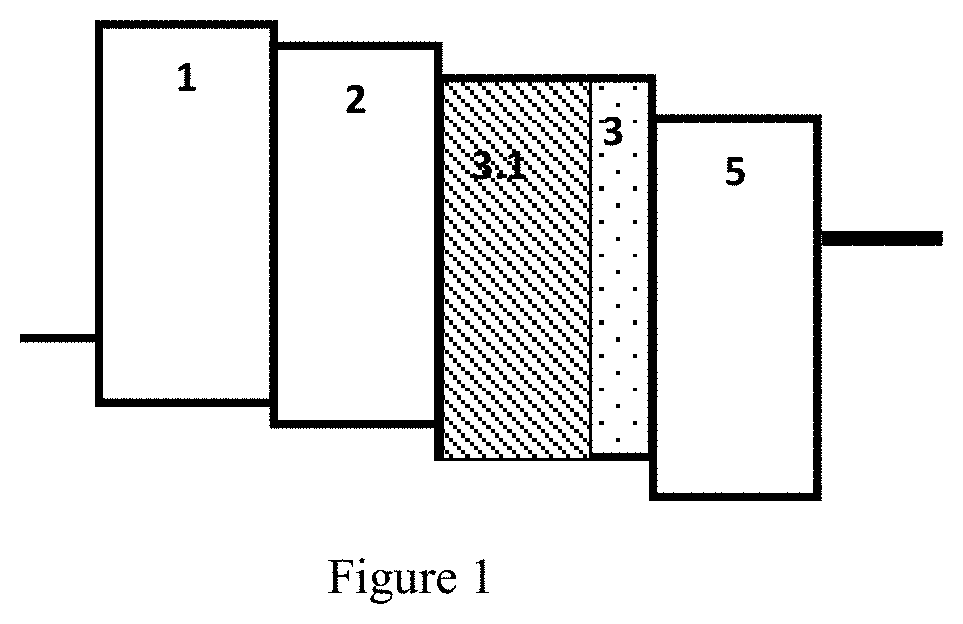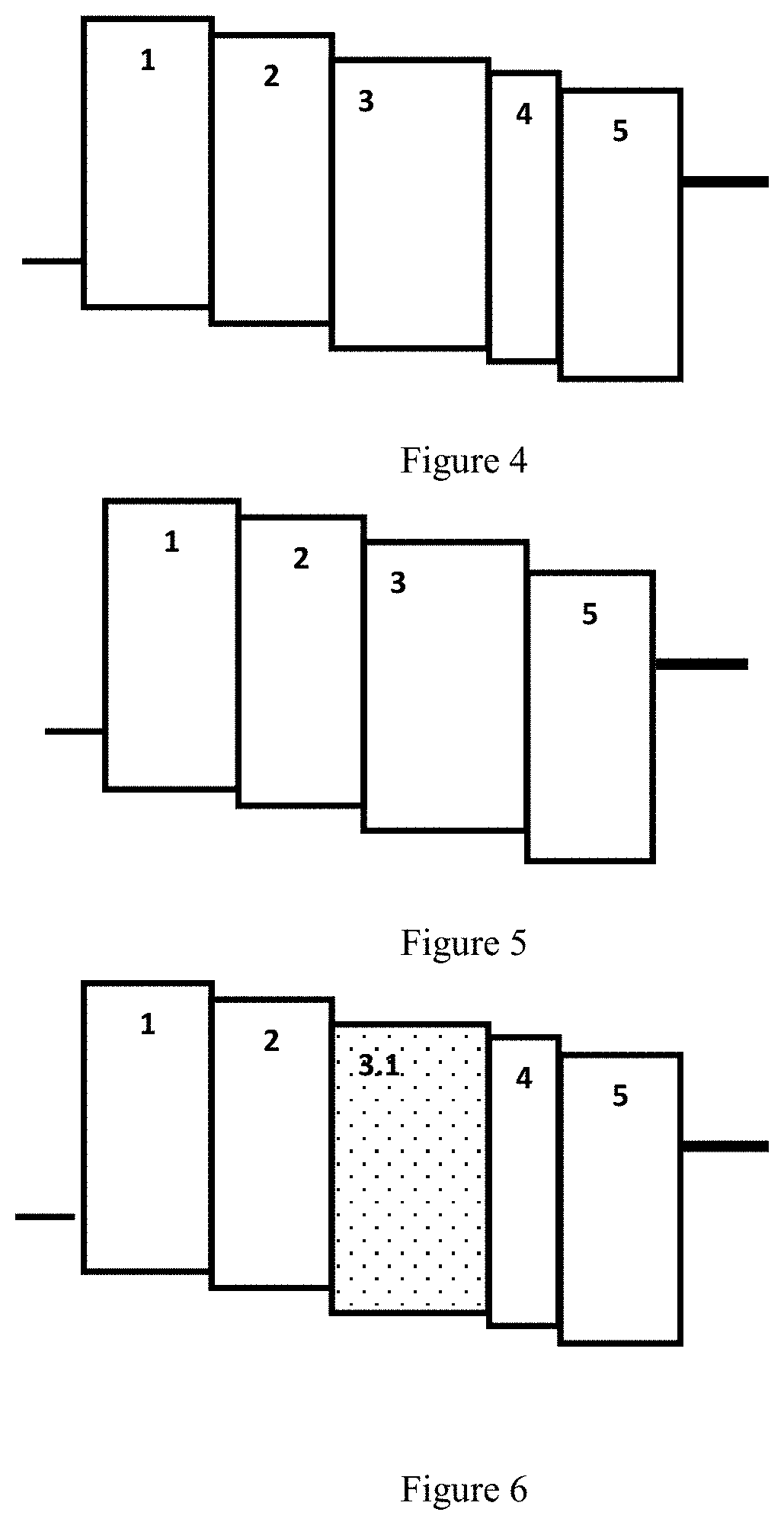Organic electroluminescent device
a technology of electroluminescent devices and organic materials, which is applied in the direction of organic semiconductor devices, luminescent compositions, chemistry apparatuses and processes, etc., can solve the problems of complex device structure, high required driving voltage, and energy loss simplify the structure and preparation process of the device, and achieve high triplet state energy level and singlet state energy level
- Summary
- Abstract
- Description
- Claims
- Application Information
AI Technical Summary
Benefits of technology
Problems solved by technology
Method used
Image
Examples
example 1
[0150]The structure of the OLED device of this Example is as shown in FIG. 1, and comprises: an anode, a hole injection layer 1, a hole transport layer 2, a luminescent layer 3, a barrier layer 4, an electron transport layer 5 and a cathode (not shown in the figure) that are successively laminated and deposited on a substrate (not shown in the figure).
[0151]In this Comparative Example, ITO serves as the anode; MTDATA:4% F4TCNQ serves as the hole injection layer 1; TCTA serves as the hole transport layer 2; the luminescent layer 3 employs the host (2-13) as the phosphorescence host material, and the green phosphorescence material Ir(ppy)3 serves as the green phosphorescence dye (the doping mass percentage of the dye in the luminescent layer is 1%); MTDATA doped Li3N serves as the electron transport layer 5; and Al serves as the cathode.
[0152]ITO / MTDATA:4% F4TCNQ(100 nm) / TCTA(20 nm) / host(2-13):1% Ir(ppy)3(30 nm) / Alq3:2% Li3N(25 nm) / Al(100 nm)
example 2
[0153]The structure of the OLED device of this Example is as shown in FIG. 1, and comprises: an anode, a hole injection layer 1, a hole transport layer 2, a luminescent layer 3, a barrier layer 4, an electron transport layer 5 and a cathode (not shown in the figure) that are successively laminated and deposited on a substrate (not shown in the figure).
[0154]In this Comparative Example, ITO serves as the anode; MTDATA:4% F4TCNQ serves as the hole injection layer 1; TCTA serves as the hole transport layer 2; the luminescent layer 3 employs the host (2-13) as the phosphorescence host material, and the green phosphorescence material Ir(ppy)3 serves as the green phosphorescence dye (the doping mass percentage of the dye in the luminescent layer is 5%); MTDATA doped Li3N serves as the electron transport layer 5; and Al serves as the cathode.
[0155]ITO / MTDATA:4% F4TCNQ(100 nm) / TCTA(20 nm) / host(2-13):5% Ir(ppy)3(30 nm) / Alq3:2% Li3N(25 nm) / Al(100 nm)
example 3
[0156]The structure of the OLED device of this Example is as shown in FIG. 1, and comprises: an anode, a hole injection layer 1, a hole transport layer 2, a luminescent layer 3, a barrier layer 4, an electron transport layer 5 and a cathode (not shown in the figure) that are successively laminated and deposited on a substrate (not shown in the figure).
[0157]In this Comparative Example, ITO serves as the anode; MTDATA:4% F4TCNQ serves as the hole injection layer 1; TCTA serves as the hole transport layer 2; the luminescent layer 3 employs the host (2-13) as the phosphorescence host material, and the green phosphorescence material Ir(ppy)3 serves as the green phosphorescence dye (the doping mass percentage of the dye in the luminescent layer is 10%); MTDATA doped Li3N serves as the electron transport layer 5; and Al serves as the cathode.
[0158]ITO / MTDATA:4% F4TCNQ(100 nm) / TCTA(20 nm) / host(2-13):10% Ir(ppy)3(3 On m) / Alq3:2% Li3N(25 nm) / Al(100 nm)
PUM
| Property | Measurement | Unit |
|---|---|---|
| singlet state energy | aaaaa | aaaaa |
| singlet state energy | aaaaa | aaaaa |
| external quantum efficiency | aaaaa | aaaaa |
Abstract
Description
Claims
Application Information
 Login to View More
Login to View More - R&D
- Intellectual Property
- Life Sciences
- Materials
- Tech Scout
- Unparalleled Data Quality
- Higher Quality Content
- 60% Fewer Hallucinations
Browse by: Latest US Patents, China's latest patents, Technical Efficacy Thesaurus, Application Domain, Technology Topic, Popular Technical Reports.
© 2025 PatSnap. All rights reserved.Legal|Privacy policy|Modern Slavery Act Transparency Statement|Sitemap|About US| Contact US: help@patsnap.com



